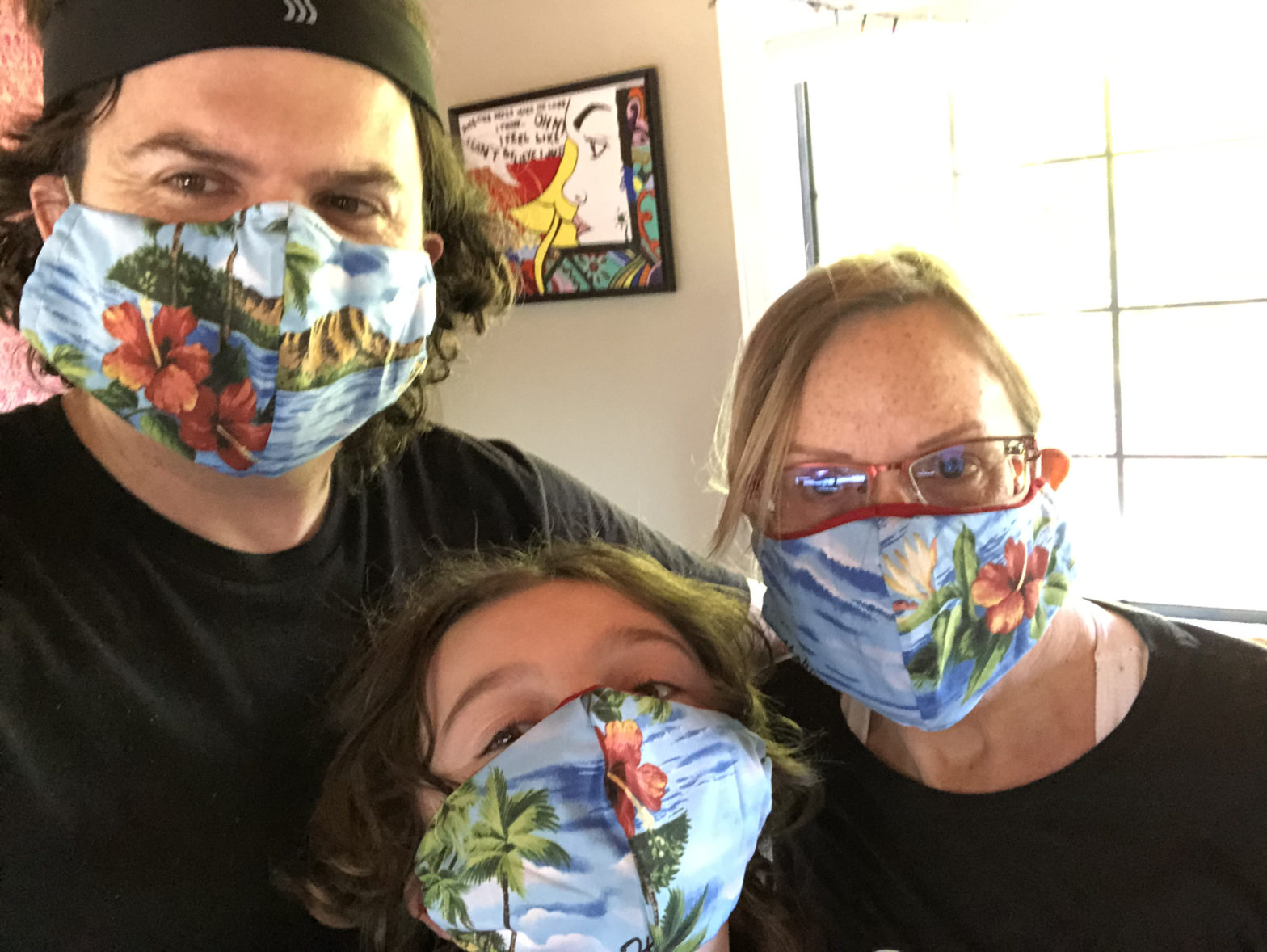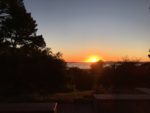Translation for my non-Aussie readers: “Doing it tough” is an Australian expression that roughly means “to do something that is hard” (sometimes willingly, sometimes not), as in: “Melbourne has been doing it tough with lockdowns.”
The Gregg-Straughan household also knows a thing or two about doing hard lockdown: we did it for eight months last year. We as a family started sheltering in place before it was in any way required where we lived (the California Bay Area), because I have pre-existing conditions that probably make me more likely both to catch and to die from the COVID. I still have close ties to Italy, so I was aware early on how dangerous this virus was.
So was my daughter – she was lobbying her university in New York to switch to online learning weeks before they finally decided to. Later, when things got truly horrific in New York, the dean apologized to her for not having taken her concerns seriously earlier!
I was watching the Johns Hopkins map with mounting dread, and hoping (against any realistic hope) that the powers that be would comprehend the risk early enough to save the US what Italy was going through. Fortunately, our local government got it: Santa Clara County I believe was the first US county to go into lockdown, on March 17, 2020.
All retail was closed except essentials like grocery stores and pharmacies. You couldn’t get into a grocery store without standing in a carefully-distanced line, wearing a mask, and having your temperature checked before you were allowed to enter – only when your turn came, because numbers inside the store were being monitored and kept small. You had to follow a prescribed path through the store and get your shopping done quickly – no changing your mind or doubling back for something you forgot.
I didn’t experience any of that firsthand, because I did not want to risk going into any kind of store for any length of time, for any reason. My last visit to any retail establishment was on March 17th – to the outdoor plant nursery. From that day until we left the US on December 21st, none of our household went inside any shop, restaurant, mall, or any other place except medical offices (in my case, for routine post-cancer checkups – I postponed all non-urgent medical care). I was able to pick up prescriptions from a drive-through window at my local Walgreens.
It wasn’t easy getting food on the table. At first no one was sure whether COVID could be spread via food or food packaging, so for the first six months we never even ordered takeout – I was cooking all our meals myself. During the first weeks, it was hard to obtain the food to cook. I was already a big fan of grocery delivery services, which I’d started using while undergoing chemo in 2015. I don’t enjoy shopping for its own sake, and never saw why I should spend time and energy buying boring stuff like toilet paper and cleaning supplies. I did shop in person for fresh foods, but in pre-pandemic times at least half our groceries and other household goods arrived via Whole Foods delivery, Amazon Pantry, Safeway, and InstaCart for Costco.
All of this became difficult the moment everyone else suddenly wanted to use these services. Amazon had recently begun experimenting in our area with one-hour free delivery from Whole Foods, but they weren’t ready for the sudden surge in demand – it became impossible to schedule any delivery at all. For weeks, friends were trading tips on how to nab a delivery slot on the Whole Foods site (“Watch it at midnight – that’s when they open new slots!”). Delivery from other sources was equally difficult to obtain.
Eventually, acquiring food became easier. Many businesses began offering online ordering with contactless delivery into your car trunk – we got alcohol and Indian groceries this way. One lifesaver was a local catering business which, rather than laying off staff or dropping their suppliers, pivoted to selling boxes of fresh fruit, vegetables, meats, and other staples, again delivered into your trunk. Some of their supplies came in restaurant quantities – I bought several 25-pound bags of flour. I got in the habit of keeping a lot of food stocked in the house, to the point that we even bought a small chest freezer, because we never knew when things could get hard again.
Flour was important because, like many people, we were making our own bread. We no longer trusted our beloved (and ridiculously expensive) artisanal Acme Bread because it had been sold in open paper bags. There’s a lot of mass-producted bread that I can’t eat because it uses soy flour or soy protein (to which I’m allergic) as an “enhancer.”
Neither Brendan nor I like sourdough, so he experimented with how to improve yeast breads from the bread machine we already owned, and eventually achieved a nice, crusty loaf. Meanwhile I learned to make a good homemade pita, and once even made decent chappatis.
I also found other food sources, such as delicious gourmet beans from Rancho Gordo. And I was growing a lot of our vegetables myself.
We were among the very fortunate in so many ways: Brendan and I both had secure jobs in tech that we could easily do from home (I had already been working mostly from home when not traveling). Netflix was late in allowing its employees to work from home, but for my sake Brendan took matters into his own hands and simply told them that he would be working from home, a week or two before they made up their minds that everyone should.
The same thing happened with his 10 year old son Mitchell’s school: we were starting to press for a stay-home option, and were eventually told we could sign a permission form and take him out – as many parents wanted to do. Then the school district finally capitulated and closed, on the same day we would have signed the form. Virtual schooling was immediately taken on by Mitchell’s mother Claire (who lived only a mile from us), allowing Brendan and me to concentrate on our jobs – another privilege for which we were and remain extremely grateful.
What was hardest was the loneliness. Brendan and I had each other, of course, and there’s no one I’d rather be stuck in a house with. But I usually see friends often, and not being able to do so is a huge gap in my life even now. As it was, we could only interact online or (after a few months) in carefully-distanced get togethers outdoors.
We were allowed out for as much exercise as we wanted, but we were cautious. Even California had its anti-mask crazies, who could be downright life-threatening – there were cases of people deliberately coughing in others’ faces out of sheer obnoxiousness. It was sad and stressful to have to worry, every time we took a walk around the neighborhood, whether we needed to be wary of any strangers we saw.
At first we had online get-togethers with friends and family, but those became harder to sustain as all of us spent more time online for work meetings, schooling, and other required activities, and Zoom burnout set in.
Over the US summer, California opened up and I felt safe with friends and colleagues in the front yard. I even (gasp!) drove in a car with a close friend to see another couple of close friends – we were masked and kept the windows open in the car, and all ate lunch together outside. It would have been possible to eat outdoors at some local restaurants, but we didn’t risk it – having my face uncovered to eat at a table on the sidewalk with random people passing nearby, many of them unmasked? No, thanks.
In August a (very unusual for the time of year) lightning storm started fires in the dry hills surrounding us on three sides. We were blanketed in smoke for days. It was sobering to realize that, had we needed to evacuate, millions of people would be trying to do the same along the one highway still open that wouldn’t take us into a fire.
As the weather turned colder and people began spending more time indoors, cases increased again, and with no vaccine in sight we were just as vulnerable as we had been in March. It was a long, dark slide into winter. Around September there finally seemed to be enough evidence that COVID wasn’t spread via food or packages, and we felt safe to start ordering in meals, though we would immediately remove the food from the packaging it came in and put it onto our own plates, then wash our hands thoroughly before eating. We were still using disinfectant wipes on any perishable groceries that couldn’t be quarantined in the garage for a few days before bringing them into the house.
Needless to say, we were not traveling. Our last trip anywhere had been a vacation in Hawaii in mid-February. From March to December, the furthest we drove was to San Francisco a couple of times, for medical appointments. We took food with us and ate it in the car near a beach.
My daughter and her partner, then living in Brooklyn, decided to get married in October. For weeks I watched the COVID numbers obsessively: the state of New York was allowing travelers in, but only from states that were at or below a certain threshold of new cases for three weeks running. California case counts were headed in the right direction, but nothing was certain, and my daughter was worried about me getting on a plane still unvaccinated. So I attended via Zoom, which was fun in its own way, but still… it broke my heart not to be present.
Meanwhile, our self-imposed lockdown wasn’t getting any easier, but going out didn’t look any safer.
At least we had the prospect of escape to Australia, and a whole lot of packing to be ready for it.




